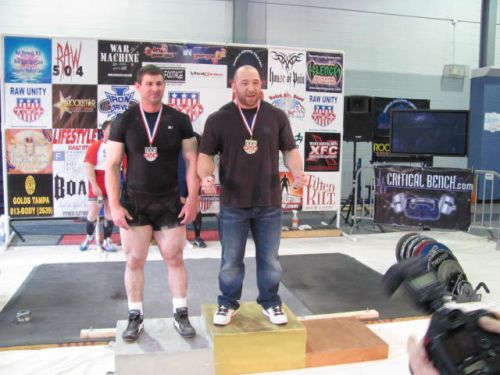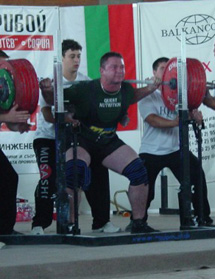RTS for the Strongman
by Mike Tuchscherer

Reactive Training Systems began as a system of training for Powerlifters. It has since evolved into a system of principles that can govern any sort of physical training from Weightlifting to general fitness, from Bodybuilding to MMA. One of the most interesting applications so far has been applying RTS to Strongman.
I like training Strongman athletes for several reasons. The biggest reason is that Strongman requires a very interesting and ever-changing skill set to be successful. Success in one show may depend heavily on absolute strength in an athlete's back where success at the next show may depend heavily on speed during walking events. Add on the comparatively complex energy system demands and you can have some pretty interesting training problems! But solving those problems is part of the fun of programming.
So without further adieu, here is a primer on using RTS to train for Strongman. Keep in mind that a complete discussion of the topic would well exceed article-length, so this will just get you thinking about the various training topics and how to address them.
The stopwatch is your friend
One central player in RTS is the Rate of Perceived Exertion, or RPE. Crossing the original concept of RPE's into the world of Strongman presents some unique challenges. The RPE is centrally based on the question, "How many reps did you have left?" While some events such as log press and 18" Deadlift can function quite well with RPE's, there are many times in Strongman where this is difficult, if not impossible, to answer. Walking movements in particular pose problems. How do you know how many reps you had left when you weren't really doing reps to begin with?
In these situations, I recommend using a stopwatch. With practice, this method can even be better than subjective RPE's altogether. Just track your times and compare them. If you wanted to be even more serious, you could even do some math to find out your average speed. If you divide the distance traveled (in feet) by the number of seconds it took you to get there, you'll get your average speed in feet per second. This can now be compared to other distances. It shouldn't take much observation to figure out your typical speeds with various weights. Then, when you see you are faster with the same weight, you know you've gotten better. If you are slower than usual on a given day, you can back down the weight to get your foot speed to the desired levels.
The challenge is to use your speed as a governor in selecting your training weights. This is difficult to do and to be honest, I don't have the answer (yet). However, I do know that the starting point is as simple as observation.

Plan your training well
Take the time to learn about planning your training. Planning training is a huge topic and doing it well on an individualized level can take a lot of work. But it can certainly pay off. One tip on planning training that could help lots of Strongmen be better prepared is to understand how to sequence training.
The first thing you should do is look at the contest you plan on entering. What events will be there? Then determine what each event will require. Let me give an example. Let's say your next show had a Log-Press-for-reps and the log weighs 220 pounds. If your 1RM is 190, you obviously have to develop greater absolute strength. But what if your 1RM is 240? This athlete also would benefit most from developing absolute strength because they will be using ~90% of their 1RM at the contest. There is very little you can do to increase the number of reps you can do at 90% of your 1RM. On the other hand, if you increase your 1RM to 275, now you can almost certainly do several more reps with the 220 pound log. But what if you are starting with a 300 pound 1RM? In this case, you would likely be best served training strength endurance in order to crank out a few more reps.
After you determine which traits you need to develop, you just need to figure out how to get there. In general, absolute strength is a function of neural efficiency and fiber cross-sectional area (generically, this is a muscle's size). So if your event will require absolute strength, first develop your cross sectional area, then neural efficiency as the contest draws closer. Other traits such as explosive strength and strength endurance can be a bit more complicated and not always clear cut. That said, a good general progression for explosive strength is cross sectional area >> absolute strength >> explosive strength. A good general progression for strength endurance is cross sectional area >> absolute strength >> strength endurance.
Adapting Fatigue Percents
Using fatigue percents to auto-regulate your training volumes is a very effective means of volume management. But just like RPE's, this can get difficult when it is applied to various unconventional movements that are commonplace in Strongman. If you are not familiar with Fatigue Percents, I apologize that I must direct you to the Reactive Training Manual for details. The topic itself is just too big for a single article.
However, if you are already familiar with Fatigue Percents, this can be a unique way to use them in the context of Strongman's walking events. If you use your speed as an "RPE", then you can fundamentally follow the same flow as you would for barbell movements. Drop the implement weight by the required percentage and continue until you can no longer keep up your speed. The number of runs you do with the implements is totally dependent on how well you withstand the acute fatigue. This allows the volume to automatically adjust to your capability for the day - a very powerful training tool.
Stay creative...
In my experience, Strongman athletes are among the most creative in terms of being resourceful in their training environment. I've seen homemade implements and a number of other things that really attest to the dedication of these athletes. Use that same creativity and determination in your overall training processes. As I said in the introduction, a complete adaptation of RTS to Strongman would exceed article length, so use the ideas here as a primer and be creative with how you implement the RTS principles. The principles of good physical training don't change with the sport, so be encouraged that you can find a way to use RTS to your advantage in Strongman!
Mike Tuchscherer is the owner of Reactive Training Systems, a company dedicated to individualized physical training. The goal of RTS is to help you become a dominant force in your sport! Learn more by visiting www.ReactiveTrainingSystems.com.
Mike himself is an accomplished Powerlifter. He has over 12 years of experience training and researching the best training methods in the world. Mike has competed in raw and single ply competitions. He recently won the Gold medal representing the USA at the 2009 World Games; becoming the first American male to ever win this distinction. His best lifts in IPF competition are a 903 squat, a 644 bench press, an 826 deadlift, and a 2342 total in the 275 pound weight class.
More Articles By Mike Tuchscherer
Return to the Workout Articles Archive
|